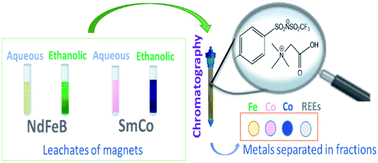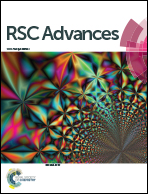Chromatographic separation of rare earths from aqueous and ethanolic leachates of NdFeB and SmCo magnets by a supported ionic liquid phase†
Abstract
The separation of rare-earth elements (REEs) from other components of end-of-life NdFeB and SmCo magnets was investigated by column chromatography. A carboxylic-acid functionalized supported ionic liquid phase (SILP) was studied as a stationary phase. The magnets were firstly leached with a dilute aqueous or ethanolic hydrochloric acid solution at room temperature. Leaching of REEs from a NdFeB magnet was similarly efficient with both lixiviants, but the REEs were more efficiently leached from a SmCo magnet with the ethanolic lixiviant. The SILP exhibited a high affinity towards trivalent cations of REEs, which were successfully recovered from the aqueous and ethanolic leachates of magnets. Divalent cations of iron and cobalt, which were the major components of the acidic aqueous leachates of magnets, were rejected by the SILP. Iron and cobalt were present as negatively charged chloro complexes in the ethanolic leachates of magnets, and were not recovered by the cation-exchanging SILP. A versatile column chromatography method is developed, suitable for the separation of REEs from iron and cobalt, either from aqueous or ethanolic leachates of permanent magnets.



 Please wait while we load your content...
Please wait while we load your content...